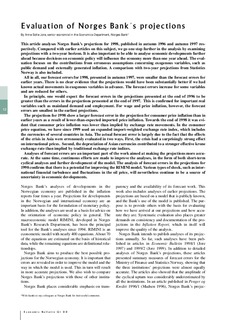| dc.description.abstract | This article analyses Norges Bank’s projections for 1998, published in autumn 1996 and autumn 1997 respectively. Compared with earlier articles on this subject, we go one step further in the analysis by examining projections with a two-year horizon. It is also important to be able to analyse economic developments further ahead because decisions on economic policy will influence the economy more than one year ahead. The evaluation focuses on the contributions from erroneous assumptions concerning exogenous variables, such as public demand and externally generated inflation. A comparison with two-year projections from Statistics Norway is also included. All in all, our forecast errors for 1998, presented in autumn 1997, were smaller than the forecast errors for earlier years. There is no clear evidence that the projections would have been substantially better if we had known actual movements in exogenous variables in advance. The forecast errors increase for some variables and are reduced for others. In principle, one would expect the forecast errors in the projections presented at the end of 1996 to be greater than the errors in the projections presented at the end of 1997. This is confirmed for important real variables such as mainland demand and employment. For wage and price inflation, however, the forecast errors are smallest in the earliest projections. The projections for 1998 show a larger forecast error in the projection for consumer price inflation than in earlier years as a result of lower-than-expected imported price inflation. Towards the end of 1998 it was evident that consumer price inflation was lower than implied by exchange rate movements. In the consumer price equation, we have since 1999 used an expanded import-weighted exchange rate index, which includes the currencies of several countries in Asia. The actual forecast error is largely due to the fact that the effects of the crisis in Asia were erroneously evaluated in two ways. First, the crisis had a surprisingly strong effect on international prices. Second, the depreciation of Asian currencies contributed to a stronger effective krone exchange rate than implied by traditional exchange rate indices. Analyses of forecast errors are an important part of the work aimed at making the projections more accurate. At the same time, continuous efforts are made to improve the analyses, in the form of both short-term cyclical analyses and further development of the model. The analysis of forecast errors in the projections for 1998 confirms that there is a potential for improving the RIMINI model. Various types of shock, such as international financial turbulence and fluctuations in the oil price, will nevertheless continue to be a source of uncertainty in economic developments. | nb_NO |

